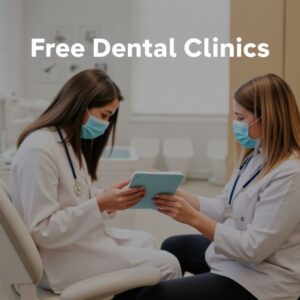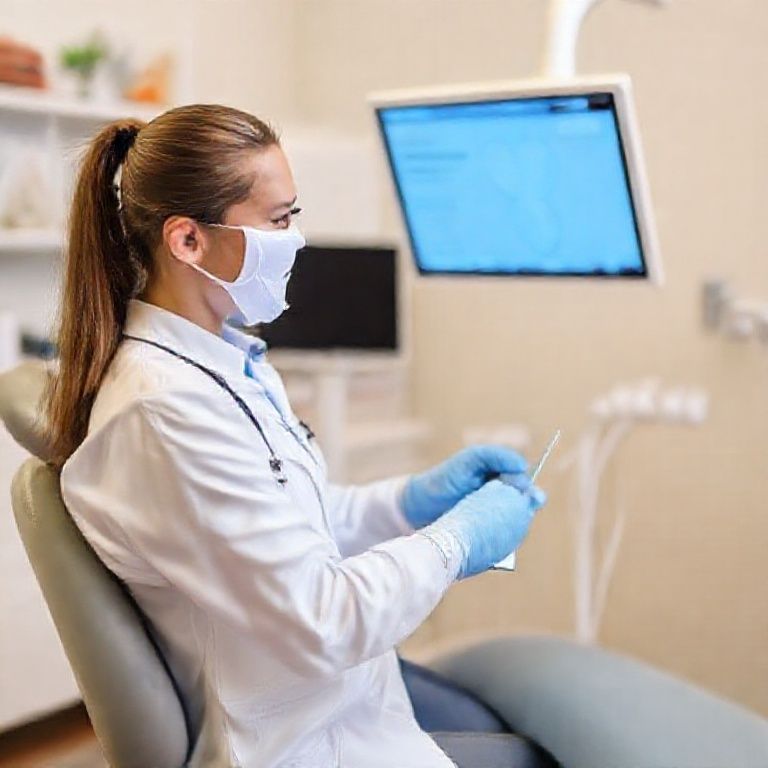A Guide to Free Dental Clinics in Ohio: Restoring Smiles and Hope
Imagine the persistent, throbbing pain of a toothache. It’s a pain that clouds your judgment, makes it impossible to concentrate at work or school, and steals the simple joy of sharing a meal with your family. Now, imagine facing that pain with the certain knowledge that you have absolutely no way to pay for a solution. This is not a hypothetical scenario for hundreds of thousands of Ohioans. It is a daily, grinding reality. In a state renowned for its industry, its agriculture, and its “heartland” values, a silent epidemic of dental neglect is eroding the health, confidence, and economic potential of its residents. The gap between those who can afford regular dental care and those who cannot is a chasm, and falling into it can have devastating consequences.
But within this crisis, there are beacons of hope. Scattered across the Buckeye State, from the bustling streets of Cleveland to the rolling hills of Appalachia, are dedicated facilities and compassionate professionals committed to bridging this divide. Free and low-cost dental clinics represent a critical safety net, offering everything from emergency extractions to full dentures, often at no cost to the patient. This article is more than just a directory; it is a comprehensive guide to navigating this essential but complex ecosystem. We will explore the reasons behind the access crisis, provide a detailed, region-by-region breakdown of available resources, and offer practical advice for those seeking care. Our goal is to empower you with knowledge, connect you with help, and restore not just your smile, but your well-being.
Understanding the Landscape: Why Dental Care is Elusive for Many Ohioans
To understand the vital role of free clinics, one must first understand the systemic barriers that prevent so many from accessing care. The problem is multifaceted, rooted in economics, geography, and a healthcare system that has historically treated the mouth as separate from the rest of the body.
The High Cost of Care
Dental care is expensive. A simple filling can cost hundreds of dollars, while a root canal and crown can easily exceed two thousand. For the 13.4% of Ohioans living at or below the federal poverty level (as of 2023 census data), and even for many in the working class, these are not manageable expenses but financial catastrophes. Most low-wage jobs do not offer employer-sponsored dental insurance, and purchasing a private plan is often prohibitively costly. For those on fixed incomes, such as seniors relying solely on Social Security, a single dental procedure can force an impossible choice between their health and their rent.
The Dental Deserts of Ohio
The challenge isn’t just cost; it’s also geography. Many rural counties in Ohio are classified as “dental deserts”—areas with a severe shortage of practicing dentists. In counties like Vinton, Monroe, and Noble, the dentist-to-population ratio is critically low. Residents in these areas may face travel times of an hour or more to reach the nearest provider, a journey complicated by a lack of reliable transportation. This geographic isolation creates a cycle of neglect, where minor issues are left untreated due to inaccessibility, only to evolve into painful and costly emergencies later.
The Ripple Effect: How Oral Health Impacts Overall Well-being
The consequences of poor oral health extend far beyond the mouth. Modern medicine has established clear and powerful links between oral disease and systemic health conditions.
-
Cardiovascular Disease: Chronic inflammation from periodontal (gum) disease is associated with an increased risk of heart attack and stroke.
-
Diabetes: Periodontal disease can make blood sugar harder to control, and diabetes, in turn, can exacerbate gum disease.
-
Respiratory Infections: Bacteria from the mouth can be aspirated into the lungs, leading to pneumonia, particularly in the elderly.
-
Pregnancy Complications: Severe gum disease has been linked to preterm birth and low birth weight.
Beyond the physical, the psychosocial impact is profound. Dental pain is a leading cause of school absences for children. For adults, missing, broken, or discolored teeth can be a source of deep shame, hindering job prospects, social interactions, and overall self-esteem. The goal of free clinics, therefore, is not merely to fix teeth, but to restore health, dignity, and opportunity.
Navigating the System: Types of Free and Low-Cost Dental Resources
The term “free dental clinic” encompasses a variety of organizations, each with its own model, funding sources, and target population. Understanding these differences is key to finding the right help.
Community Health Centers (FQHCs)
Federally Qualified Health Centers (FQHCs) are a cornerstone of the public health system. They receive federal funding to provide comprehensive care, including dental services, to underserved populations, regardless of their ability to pay. They operate on a sliding fee scale based on income and family size. This means that while services are not always entirely free, they are made significantly more affordable.
-
How to Find Them: FQHCs have locations throughout Ohio. A prime example is The Ohio State University Wexner Medical Center’s Dental Clinic or Neighborhood Health Association in Toledo.
Non-Profit and Charitable Clinits
These are the organizations most people envision when they think of “free clinics.” They are typically funded by donations, grants, and the work of volunteer dental professionals. Some are stand-alone clinics open year-round, while others may operate on specific days of the week or month.
-
Examples: The Free Medical Clinic of Greater Cleveland and Project St. Joseph in Columbus are stellar examples of this model, offering a wide range of services completely free of charge to qualified individuals.
Mission of Mercy and Pop-Up Dental Events
These are large-scale, temporary clinics that provide a massive volume of free care over a short period, usually a weekend. They are often held in fairgrounds or convention centers and are staffed entirely by volunteers. Patients are typically seen on a first-come, first-served basis, and lines can form hours or even days in advance.
-
Key Organizers: The Ohio Dental Association and Remote Area Medical (RAM) are major organizers of such events in the state. These events are crucial for addressing acute needs but are not a substitute for continuous care.
Dental School Clinics
The dental schools at The Ohio State University and Case Western Reserve University offer clinics where dental students provide care under the close supervision of licensed faculty. The cost of treatment is typically 30-50% less than in a private practice. While not free, this is a highly affordable option for complex procedures.
-
Advantage: The care is thorough and covers a wide range of specialties, from orthodontics to oral surgery.
-
Consideration: Appointments can be longer due to the educational nature of the clinic.
Government Assistance Programs (Medicaid/MyCare Ohio)
In Ohio, dental coverage for adults is provided through the Medicaid program. However, it is critical to understand that not all dentists accept Medicaid, and the coverage for adults can be more limited than for children. Coverage for children under 21 is comprehensive under the Early and Periodic Screening, Diagnostic, and Treatment (EPSDT) benefit.
-
Key Point: Simply having Medicaid does not guarantee access to a dentist. You must find a provider who accepts it, which can be a challenge in many areas.
A Regional Directory: Free and Low-Cost Dental Clinics Across Ohio
The following directory provides a snapshot of key resources across Ohio’s major regions. This is not an exhaustive list, and you MUST call ahead to verify hours, eligibility, and appointment procedures.
Northeast Ohio (Cleveland, Akron, Youngstown)
This heavily populated region has a strong network of charitable organizations.
-
The Free Medical Clinic of Greater Cleveland: A pillar of the community, offering comprehensive medical and dental care free of charge to uninsured, low-income adults. Services include exams, cleanings, fillings, and extractions. (Appointment required).
-
Portage County Dental Clinic (Rootstown): Provides dental care on a sliding fee scale to low-income, uninsured Portage County residents.
-
Community Health Center of Northeast Ohio (Multiple Locations): An FQHC with several locations offering medical, dental, and behavioral health services on a sliding scale.
Northwest Ohio (Toledo, Findlay)
-
Neighborhood Health Association (Toledo): An FQHC network operating several dental clinics, including the Catherine Cobb Dental Clinic and the Jean M. Kessler Dental Clinic. They provide care on a sliding fee scale.
-
Community Dental Care (Findlay): A non-profit clinic dedicated to providing affordable dental care to children and adults, with fees based on income and family size.
Central Ohio (Columbus, Dayton, Springfield)
The state capital region features a mix of large FQHCs and dedicated charitable clinics.
-
Project St. Joseph (Columbus): A volunteer-driven clinic that offers free dental care every Wednesday evening. Services are first-come, first-served for emergency extractions and fillings.
-
Columbus Neighborhood Health Center (Multiple Locations): A large FQHC system providing integrated care, including full-service dentistry, on a sliding scale.
-
Good Samaritan Dental Clinic (Dayton): Operated by the St. Vincent de Paul Society, this clinic provides free dental care to low-income, uninsured adults.
Southwest Ohio (Cincinnati, Hamilton)
-
Cincinnati Dental Society’s Donated Dental Services (Cincinnati): This program matches low-income, elderly, or disabled individuals with volunteer dentists who donate their services.
-
Community Health Alliance (Hamilton): An FQHC providing medical, dental, and pharmacy services on a sliding fee scale.
Southeast Ohio (Athens, Chillicothe, Portsmouth)
This region, grappling with rural poverty and dental deserts, relies heavily on FQHCs and mobile clinics.
-
Hopewell Health Centers (Multiple Locations): A critical FQHC network serving numerous counties in Southeast Ohio with integrated medical and dental care.
-
Health Source of Ohio (Multiple Locations): Another major FQHC provider in the region, offering sliding scale dental services.
-
Muskingum Valley Health Centers (Multiple Locations): Provides comprehensive healthcare, including dental, to residents in several counties.
Comparison of Free and Low-Cost Dental Care Providers in Ohio
| Provider Type | Key Feature | Cost Structure | Best For | Example in Ohio |
|---|---|---|---|---|
| Charitable Clinic | Volunteer-driven, donation-funded | Often completely free | Uninsured, very low-income individuals in acute need | The Free Medical Clinic of Greater Cleveland |
| FQHC (Community Health Center) | Federally funded, comprehensive care | Sliding Fee Scale (based on income) | Low-income families and individuals needing ongoing care | Hopewell Health Centers (Southeast OH) |
| Dental School Clinic | Care provided by supervised students | Reduced fee (30-50% less) | Patients needing complex work who can afford a reduced cost | The Ohio State University College of Dentistry |
| Mission of Mercy Event | Large-scale temporary clinic | Completely free | Anyone in need of immediate, basic care; must be able to wait in line | Ohio Dental Association Mission of Mercy |
| Medicaid | Government insurance for low-income | Free or very low co-pay | Eligible children and adults (but must find a participating dentist) | State of Ohio Department of Medicaid |
Beyond the Cleaning: Specialized Services and Emergency Care
What Services Are Typically Offered?
Free and low-cost clinics focus on essential care to alleviate pain, prevent disease, and restore basic function. Common services include:
-
Diagnostic: Exams and X-rays.
-
Preventive: Cleanings, fluoride treatments, and sealants (especially for children).
-
Restorative: Fillings for cavities.
-
Surgical: Extractions (tooth removal).
-
Prosthetic: Dentures and partials (though there is often a long waitlist for these services due to high demand and cost).
More complex procedures like root canals, crowns, bridges, and implants are rarely available at no cost and are typically only accessible through dental school clinics or very specialized charitable programs.
Handling Dental Emergencies on a Budget
A dental emergency—such as a severe toothache, abscess, or broken tooth—can be terrifying without financial resources. Here is a step-by-step action plan:
-
Call 2-1-1: Dial 211 from any phone in Ohio. This is a free, United Way-run helpline that can provide the most up-to-date information on emergency dental resources in your specific county.
-
Contact FQHCs: They often have provisions for handling emergency cases and can work with you on payment.
-
Search for “Emergency Dental Days”: Some charitable clinics designate specific days or hours for walk-in emergency care (extractions only).
-
Consider a Dental School: The emergency clinics at OSU or Case Western may be your most affordable option for complex emergencies outside of a free clinic.
-
Go to the ER for Life-Threatening Issues: Hospital emergency rooms cannot perform dental procedures, but they can prescribe antibiotics for infections and pain medication. This is a last resort for a severe facial swelling or trauma, and they will direct you to follow up with a dentist.
Pediatric Dental Care: Ensuring a Healthy Start
Children are a top priority for public health initiatives. Through Medicaid and the Children’s Health Insurance Program (CHIP), virtually all low-income children in Ohio are eligible for comprehensive dental coverage. The challenge, again, is finding a provider. FQHCs are often the best bet for ensuring children receive regular check-ups, cleanings, and treatment.
Preparing for Your Visit: A Step-by-Step Guide
Being prepared can make the difference between receiving care and being turned away.
Documentation You’ll Likely Need
-
Photo ID: Driver’s license, state ID, or passport.
-
Proof of Income: Recent pay stubs, a previous year’s tax return, or a letter from an employer. If you are unemployed, be prepared to sign a form stating so.
-
Proof of Residence: A utility bill, lease agreement, or any mail with your current address.
-
Proof of Household Size: If applying for a family, you may need birth certificates or other documentation for dependents.
What to Expect: The Patient Journey
-
Intake and Eligibility Screening: You will fill out detailed paperwork about your medical history, income, and insurance status.
-
Financial Counseling: A staff member will review your financial information to determine if you qualify for free care or a sliding scale.
-
The Dental Exam: A dentist or hygienist will perform a limited or comprehensive exam to assess your needs.
-
Treatment Planning: Due to high demand, clinics often must prioritize the most urgent needs. You may not receive all the treatment you need in one visit. An extraction for a painful tooth will take precedence over a cleaning.
-
Treatment and Follow-up: You will receive the agreed-upon treatment and be given instructions for follow-up care or future appointments.
Tips for a Successful Clinic Experience
-
Call Early: Phone lines are often busy. Call as soon as they open.
-
Be Patient and Polite: Staff and volunteers are often overworked. Courtesy goes a long way.
-
Be Flexible: Be prepared to accept the treatment that is most urgently needed, even if it’s not the one you were hoping for.
-
Ask Questions: Understand what is being done and what your aftercare responsibilities are.
The Volunteers’ Perspective: The Heartbeat of Free Clinics
Free clinics cannot exist without the generosity of volunteers. Dentists, dental hygienists, assistants, and laypeople donate thousands of hours each year. Dr. Angela Roberts, a dentist who volunteers monthly at a clinic in Akron, shares her perspective: “We see the human cost of our broken system every day. The relief on a patient’s face when their pain is finally gone… that’s why we do it. It’s not just about pulling a tooth; it’s about giving someone their life back.” These volunteers are the indispensable heroes of this story, providing not just professional skill but also compassion and dignity to every patient they serve.
Advocacy and the Future: Building a Sustainable Model for Dental Care
While charitable clinics are vital, they are not a long-term systemic solution. Advocacy for policy change is essential. Key areas for improvement include:
-
Increasing Medicaid Reimbursement Rates: This is the single most important factor in encouraging more private dentists to accept Medicaid patients.
-
Supporting Dental Therapist Programs: Mid-level dental providers, similar to physician assistants in medicine, could extend care into underserved areas under the supervision of a dentist.
-
Integrating Oral Health into Primary Care: Training pediatricians and family doctors to perform basic screenings, apply fluoride varnish, and provide referrals can catch problems early.
-
Public Education: Continued emphasis on the importance of prevention through community water fluoridation and school-based educational programs.
Supporting organizations like the Ohio Dental Association and Oral Health Ohio that lobby for these changes is crucial for building a future where free clinics are the exception, not a necessity.
Conclusion
Navigating the world of free dental care in Ohio requires patience and persistence, but vital resources do exist. From the steadfast FQHCs to the compassionate volunteer clinics, a network of support is dedicated to restoring both oral health and personal dignity. By understanding the system, preparing for appointments, and advocating for long-term change, Ohioans can overcome barriers to care and reclaim the fundamental right to a healthy, pain-free smile.
Frequently Asked Questions (FAQs)
1. I have a job, but no dental insurance. Can I still go to a free clinic?
Yes. Most free and sliding-scale clinics base eligibility on your income and family size, not your employment status. If your income falls below a certain threshold (often 200% of the Federal Poverty Level), you will likely qualify for reduced-cost or free care.
2. What if I need a root canal or a crown, but the clinic only does extractions?
This is a common and difficult situation. Free clinics prioritize pain relief and infection control, which often means extraction is the only option they can provide for a diseased tooth. For more complex restorative work, you will need to explore dental school clinics, seek out a rare charitable program that offers such services, or discuss payment plans with a private dentist.
3. How long will I have to wait for an appointment or to be seen at a walk-in clinic?
Wait times can be long. For non-emergency appointments at an FQHC, you may wait several weeks or months. For walk-in emergency clinics, patients often line up hours before the doors open. It is imperative to call ahead for the specific clinic’s policies.
4. Do these clinics provide dentures?
Many do, but it is often one of their most in-demand services, leading to long waitlists—sometimes a year or more. You will need a comprehensive exam to determine eligibility and be placed on a list.
5. I am a senior on Medicare. Why doesn’t it cover dental, and where can I go?
Traditional Medicare (Parts A & B) does not cover routine dental care. This is a significant gap in the system for seniors. Your best options are clinics that serve all low-income adults, regardless of age, such as FQHCs or charitable clinics. Some Medicare Advantage (Part C) plans may offer dental benefits, so check your plan details.
Additional Resources
-
Ohio Department of Health – Oral Health Program: Provides data, maps of dental deserts, and public health initiatives. https://odh.ohio.gov/
-
211: Your first call for help. Dial 211 or visit https://211.org/ to find local resources.
-
Ohio Dental Association (ODA): Find a dentist, learn about Mission of Mercy events, and access oral health information. https://www.oda.org/
-
National Association of Free & Charitable Clinics (NAFC): Has a clinic locator tool. https://www.nafcclinics.org/
-
Remote Area Medical (RAM): Check their schedule for pop-up clinics in Ohio and neighboring states. https://www.ramusa.org/
-
The Ohio State University College of Dentistry Patient Care: Information on their affordable clinic services. https://dentistry.osu.edu/patient-care
-
Case Western Reserve University School of Dental Medicine Patient Care: Details on their clinic and services. https://dental.case.edu/patient/
Date: October 18, 2025
Author: The Public Health Advocacy Group
Disclaimer: The information in this article is for informational purposes only and does not constitute medical or legal advice. Clinic schedules, availability, and eligibility requirements change frequently. We strongly recommend contacting clinics directly to confirm details before visiting.



